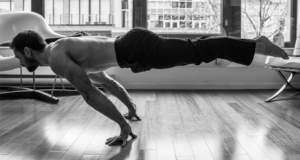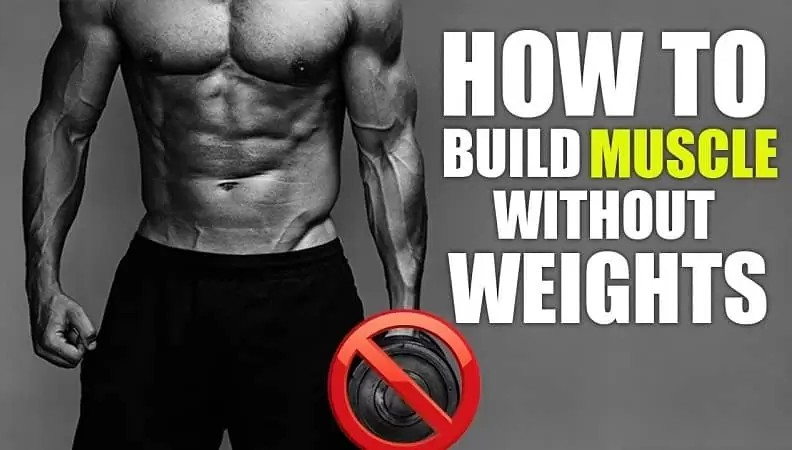You don’t need a gym full of equipment or heavy weights to build muscle, and you can achieve great results without lifting weights. Bodyweight exercises, resistance bands, and everyday household items can be highly effective tools for developing strength and muscle mass. Whether you’re working out at home, traveling, or simply want to switch things up, these seven methods will help you build muscle and improve your overall fitness without the need for weights.
In this detailed guide, we’ll explore seven highly effective bodyweight exercises and strategies to build muscle, break down each exercise’s benefits, and provide tips on how to progress. By the end, you’ll have all the tools you need to design an effective workout routine that delivers results without any traditional weights.
Benefits of Body weight Strength Training
Body weight strength training is an incredibly effective and accessible way to enhance your overall health and fitness.
One of the greatest advantages of body weight strength training is its convenience. You can perform these exercises anywhere, whether at home, in a park, or even while traveling. This makes it easier to stick to a consistent workout routine, which is crucial for long-term success. Additionally, body weight exercises are highly versatile and can be modified to suit any fitness level, from beginners to advanced athletes.
Here are the steps to Build muscle without adding weight
1. Bent-Over Rows: Strengthen the back using body weight
Bent-over rows are a fantastic exercise for building the muscles of the upper back, shoulders, and biceps. Bent-over rows are also excellent for improving posture by strengthening the muscles that support the spine.
While traditionally performed with weights, you can achieve similar benefits without lifting weights by substituting household objects such as water jugs, bags of rice, or resistance bands to mimic the movement.
How to perform Ben-over row
- Stand with your feet hip-width apart and hinge at the hips, keeping your back flat and chest lifted.
- Hold two household objects (like water jugs) or resistance bands with your palms facing each other.
- Pull the objects towards your waist, keeping your elbows close to your body.
- Squeeze your shoulder blades together at the top, then lower back down with control.
Progressions for Muscle growth
- Inverted Rows: If you have access to a bar, lie underneath it and pull your chest towards the bar while keeping your body in a straight line.
- Single-Arm Rows: Perform the movement with one arm at a time to increase the challenge and allow for greater focus on each side of your back.
- Resistance Band Rows: Secure a resistance band to a sturdy object and pull the band towards your body, mimicking the rowing motion.
How bent-over rows build muscle: This movement targets the muscles of the upper back and shoulders, promoting balanced muscle development and helping to improve posture. The pulling motion engages the biceps as well, making it a well-rounded exercise for the upper body.
2. Push-Ups:
This versatile movement allows for endless variations, enabling you to challenge yourself as you progress. Push-ups are the quintessential bodyweight exercise for building upper body muscle, primarily targeting the chest, shoulders, triceps, and core. Push-ups can be performed virtually anywhere, making them one of the most accessible exercises for building muscle.
How to perform Push-Up
- Start in a plank position with your hands slightly wider than shoulder-width apart, arms extended, and feet together.
- Engage your core and glutes to keep your body in a straight line from head to heels.
- Lower your body by bending your elbows until your chest touches the floor, ensuring your elbows stay close to your sides.
- Push through your palms to return to the starting position.
Variations to Maximize Muscle Growth
- Plyometric Push-Ups: Explode off the ground at the top of the movement to add a plyometric element, activating fast-twitch muscle fibers for power and strength.
- Diamond Push-Ups: Place your hands closer together with your thumbs and index fingers forming a diamond shape. This variation emphasizes your triceps and inner chest.
- Incline Push-Ups: Perform push-ups with your hands elevated on a bench or sturdy platform. This makes the movement easier for beginners.
- Decline Push-Ups: Place your feet on an elevated surface to increase the difficulty and place more emphasis on the upper chest and shoulders.
How Push-Ups Build Muscle: Push-ups are a compound movement, meaning they work multiple muscle groups at once. This allows you to build significant upper body muscle while also engaging the core for stability. By progressively increasing the difficulty with variations, push-ups offer continuous muscle-building potential.
3. Walking Lunges with Resistance Bands
Walking lunges with resistance bands activate the muscles of the lower body, especially the quads, hamstrings, and glutes. The bands add tension, forcing the muscles to work harder throughout the movement.
Resistance bands are an excellent tool for adding resistance to bodyweight exercises like lunges, making them more effective for resistance training and building muscle.
How to Perform Walking Lunges with Resistance Bands
- Loop a resistance band around your thighs, just above your knees.
- Step forward into a lunge while keeping the band tight to activate your glutes and thighs.
- Push through your front heel to return to a standing position, then step forward with the opposite leg.
- Repeat for the desired number of repetitions, maintaining tension on the band.
Progression for Muscle Growth
- Slow Down the Movement: Perform each lunge more slowly to increase time under tension and further challenge the muscles.
- Use a Thicker Band: Increase the difficulty by using a thicker resistance band.
Why Walking Lunges with Resistance Bands Build Muscle: The added resistance from the bands increases muscle activation in the legs and glutes. Walking lunges also improve balance, coordination, and stability, making them a highly effective exercise for building muscle without weights.
4. Pull-Ups
Pull-ups are one of the most effective bodyweight exercises for developing upper body strength and muscle. They primarily target the lats, but also work the biceps, shoulders, and core. While a pull-up bar is required, this simple piece of equipment can be easily installed in doorways or used in outdoor workout areas.
How to perform Pull-Ups
- Grab the bar with your palms facing away from you, hands slightly wider than shoulder-width apart.
- Hang from the bar with your arms fully extended, engaging your core.
- Pull your chest towards the bar by squeezing your shoulder blades together.
- Lower yourself back down to the starting position with control.
Pull-Up Variations for Muscle Growth:
- Assisted Pull-Ups: Use a resistance band or partner to help lift part of your body weight as you build strength.
- Chin-Ups: Use an underhand grip (palms facing you) to place more emphasis on the biceps.
- Negative Pull-Ups: Jump to the top of the bar and slowly lower yourself down. This variation focuses on the eccentric phase, helping build strength.
Why Pull-Ups Build Muscle: Pull-ups are a compound movement that targets multiple muscle groups, making them highly efficient for building upper body muscle mass. The pulling motion also helps develop grip strength, which is essential for overall upper body development.
5. Squats
Squats are one of the best exercises for building muscle in the lower body, targeting the quadriceps, hamstrings, glutes, and calves. Even without weights, squats can effectively increase muscle mass and endurance. Incorporating squats into your fitness routine can significantly enhance lower body strength and endurance.
As a functional exercise, squats mimic movements like sitting, standing, and lifting, making them essential for everyday strength.
How to Perform Squats
- Pistol Squats: Perform a one-legged squat while extending the other leg in front of you. This advanced variation builds unilateral strength and improves balance.
- Wall Squats: Hold a squat position with your back against a wall to increase muscle endurance and isometric strength.
- Jump Squats: Add a plyometric element by exploding into a jump at the top of the squat. This engages fast-twitch muscle fibers and increases intensity.
How Do Squats Build Muscle: Squats engage some of the largest muscle groups in the body, including the quads, hamstrings, and glutes. This large muscle engagement stimulates the production of growth hormones like testosterone, which is critical for muscle development. Additionally, squats improve functional strength, balance, and mobility.
6. Planks
Planks are one of the most effective exercises for strengthening your core, but they also engage your shoulders, glutes, and legs. Planks are also a great isometric exercise, which helps build muscle endurance by holding tension in the muscles without movement.
Holding a plank requires your body to engage the deep stabilizing muscles of the core, which improves posture, stability, and endurance.
How to perform a Plank
- Start in a forearm plank position, with your forearms on the ground and elbows directly under your shoulders.
- Keep your body in a straight line from head to heels, engaging your core and glutes.
- Hold the position for as long as possible, aiming for at least 30 seconds to start.
Variations for Building Muscle:
- Plank with Leg Lifts: While holding the plank position, lift one leg at a time to engage the glutes and lower back more intensely.
- Side Plank: Rotate your body and support your weight on one forearm and the side of your foot. This variation targets the obliques and improves stability.
Why Planks Build Muscle: Planks engage the core muscles as well as the shoulders, glutes, and legs. By adding variations like leg lifts or transitioning to a side plank, you can increase muscle activation and target different areas of the body.
7. Lunges
Lunges are another fantastic lower body exercise that targets the quads, hamstrings, and glutes while also challenging balance and core stability. Lunges are a versatile form of resistance training that can be easily incorporated into any workout regimen. Lunges work each leg independently, making them excellent for correcting muscle imbalances and improving coordination.
How to Perform Lunges
- Start by standing tall with your feet together.
- Take a large step forward with one leg, lowering your hips until both knees are bent at a 90-degree angle.
- Ensure your front knee stays aligned over your ankle, and your back knee hovers just above the floor.
- Push through your front heel to return to the starting position, then repeat on the other side.
Lunge Variations to Increase Muscle Growth
- Reverse Lunges: Step backward into the lunge to shift the emphasis onto the glutes and hamstrings, which is easier on the knees.
- Jumping Lunges: Add a plyometric component by jumping and switching legs in mid-air. This explosive movement builds power and endurance.
- Walking Lunges: Instead of stepping back to the starting position, continue moving forward with each lunge. This keeps the muscles under tension for a longer period.
Why Lunges Build Muscle: Lunges engage the entire lower body while simultaneously challenging your balance and stability. By incorporating both dynamic and static lunges, you can increase muscle activation, improve mobility, and prevent muscle imbalances.

Inconclusion
Building muscle without weights is not only possible but also highly effective when using the right exercises and techniques. By incorporating bodyweight movements like push-ups, squats, lunges, pull-ups, bent-over rows, planks, and resistance band exercises, you can create a well-rounded routine that challenges your muscles, improves endurance, and promotes muscle growth. By incorporating these exercises into your fitness routine, you can achieve significant muscle growth and overall fitness improvements.

